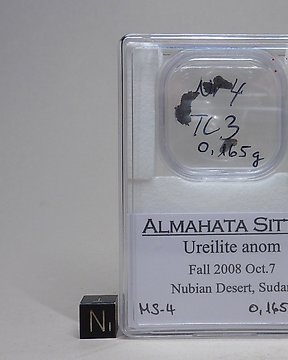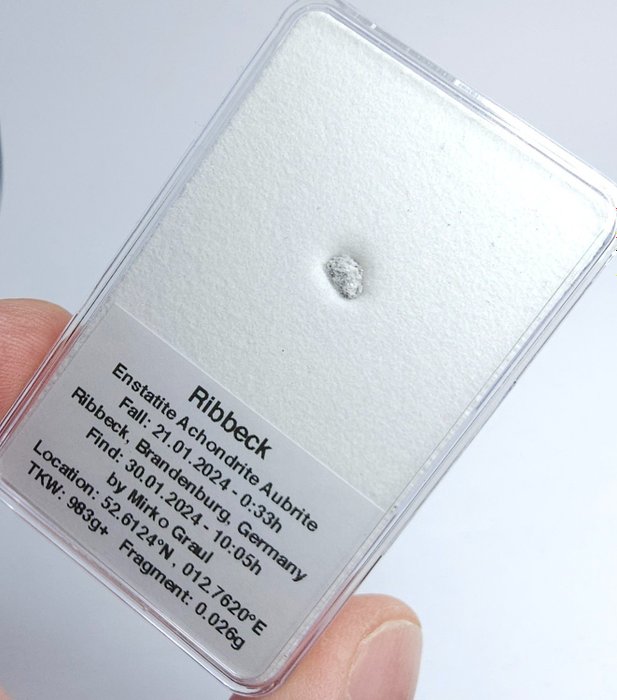
Almahata Sitta meteorit Ureilit anomal - 0.16 g
Nr. 82824789

Nr. 82824789

Reminder:
This item is a micro and to have a clearer idea of the size in the photos there is a CM scale cube.
Ribbeck 52°37’15"N, 12°45’40"E
Brandenburg, Germany
Confirmed fall: 2024 Jan 21
Classification: Enstatite achondrite (Aubrite)
History: (P. Jenniskens, SETI; L. Hecht, A. Greshake, MNB; J. Helbert, DLR): A small asteroid 2024 BX1 was discovered at 21:48 UTC on 20 January 2024, by Hungarian astronomer K. Sárneczky observing from the Piszkéstet Station of Konkoly Observatory, Mátra Mountains, Hungary. From early astrometry, NASA’s Scout and ESA’s Meerkat Asteroid Guard impact hazard assessment systems identified the object as a potential impactor, gradually narrowing the impact time to 0:33 UTC on 21 January, and in the half hour before impact predicting it to pass in a steep trajectory over the village of Nennhausen about 60 km west of Berlin, Germany. At that time, a fireball was observed by many eyewitnesses and recorded by allsky cameras of the European Fireball Network, IMO/AllSky7, FRIPON and by video security cameras. Bolide analysis and strewn field calculations performed by P. Spurný and J. Borovička (Astronomical Institute of the Czech Academy of Sciences), using an ALADIN model wind profile provided by R. Brožková (Czech Hydrometeorological Institute), indicated that strong winds blew the surviving meteorites in a south-east direction, predicting the meteorites to fall just south of the village of Ribbeck, between Retzow and Berge. The calculations were confirmed by D. Vida (UWO) based on a WTF model wind profile provided by H. Devillepoix (Curtin University, Australia). Ribbeck is known from an 1889 poem by T. Fontane, "Herr von Ribbeck auf Ribbeck im Havelland," well known to German school children. Starting on 22 January, searches were conducted by a team of scientists and students from the Museum für Naturkunde Berlin (MNB), the German Aerospace Center (DLR), the Free University Berlin (FUB), the Technical University Berlin (TUB), SETI, and members of the Arbeitskreis Meteore e.V. (AKM), as well as by professional and amateur meteorite hunters. Spectral observations of the fireball in the European Fireball Network indicated that the meteorites were poor in iron and possibly rich in enstatite. Due to the terrestrial appearance of the meteorites, the first find was made not until 25 January, when F. Nikodem, A. Owczarzak, M. Nebelski and K. Kmieciak of Poland, found the first meteorite on a field just west of Ribbeck broken up into three fragments totaling 171 g. The next morning, FUB students D. Dieter and C. Weihe located two small meteorites, 5.2 and 3.1 g, that confirmed the calculated location of the strewn field and the ambient winds. Several tens of meteorites were found in the next days. The largest fragment so far is a 225 g found by K. Kmieciak on 29 January.
Physical characteristics: (A. Greshake, C. Hamann, L. Hecht, MNB) The various individuals show rounded, egg-shaped, and angular shapes, have a gray-white patchy appearance and are partly to fully covered by fresh, whitish to dark grayish, often intensely cracked fusion crust. In many cases, the fusion crust contains transparent, often highly vesicular areas that appear to cover the dull gray and dull white areas in the form of thin veneers or stringers of quenched melt. Some rocks are fragmented, thereby exposing the whitish interior with large mineral grains already visible to the naked eye.
Petrography: (A. Greshake, C. Hamann, L. Hecht, MNB) The meteorite is a coarse-grained achondritic breccia predominantly composed of large, up to 1.2 cm sized, mostly angular whitish enstatite grains, less abundant, up to 1.5 mm sized forsterite crystals, and minor sodic feldspar set in a fine-grained interstitial cataclastic matrix consisting of related material. Opaque phases include troilite, alabandite, oldhamite, heideite, keilite, djerfisherite, kamacite, and taenite. Enstatite and forsterite show pronounced undulatory extinction. All phases are intensely fractured and enstatite contains several sets of planar cracks. No diopside detected.
Geochemistry: Enstatite: Fs0Wo0.7±0.1 (Fs0Wo0.6-0.9, n=10); olivine: Fa0, n=10; plagioclase: An1.4-4.8Ab93.1-96.2Or2.0-2.4, n=5); troilite contains : 0.18±0.01 wt% Cr and 0.94±0.3 wt% Ti, N=3; kamacite contains : 4.65±0.11 wt% Ni, 0.94±0.2 wt% Co, and 0.07±0.01 Si, N=3; taenite contains : 32.4±0.3 wt% Ni, 0.56±0.2 wt% Co, and 0.10±0.01 Si, N=3
Classification: Aubrite
Specimens: Numerous fragments ranging from 225 to 2 g have been recovered. A detailed list of major masses and their respective finder and holder can be found at https://karmaka.de/?p=34832. 30 g is at MNB.
State/Prov/County: Brandenburg
Date: 2024 Jan 21
Latitude: 52°37'15"N
Longitude: 12°45'40"E
Mass (g): 983
Pieces: many
Class: Aubrite
Shock stage: moderate
Weathering grade: low
Fayalite (mol%): 0
Ferrosilite (mol%): 0
Wollastonite (mol%): 0.7
Classifier: A. Greshake, MNB
Type spec mass (g): 30
Type spec location: MNB
Main mass: anonymous
Comments: Submitted by Ansgar Greshake
This lot has no reserve price and comes with its certificate of authenticity.
Thanks for your interest.
Sådan køber du hos Catawiki
1. Opdag noget særligt
2. Afgiv det højeste bud
3. Foretag en sikker betaling